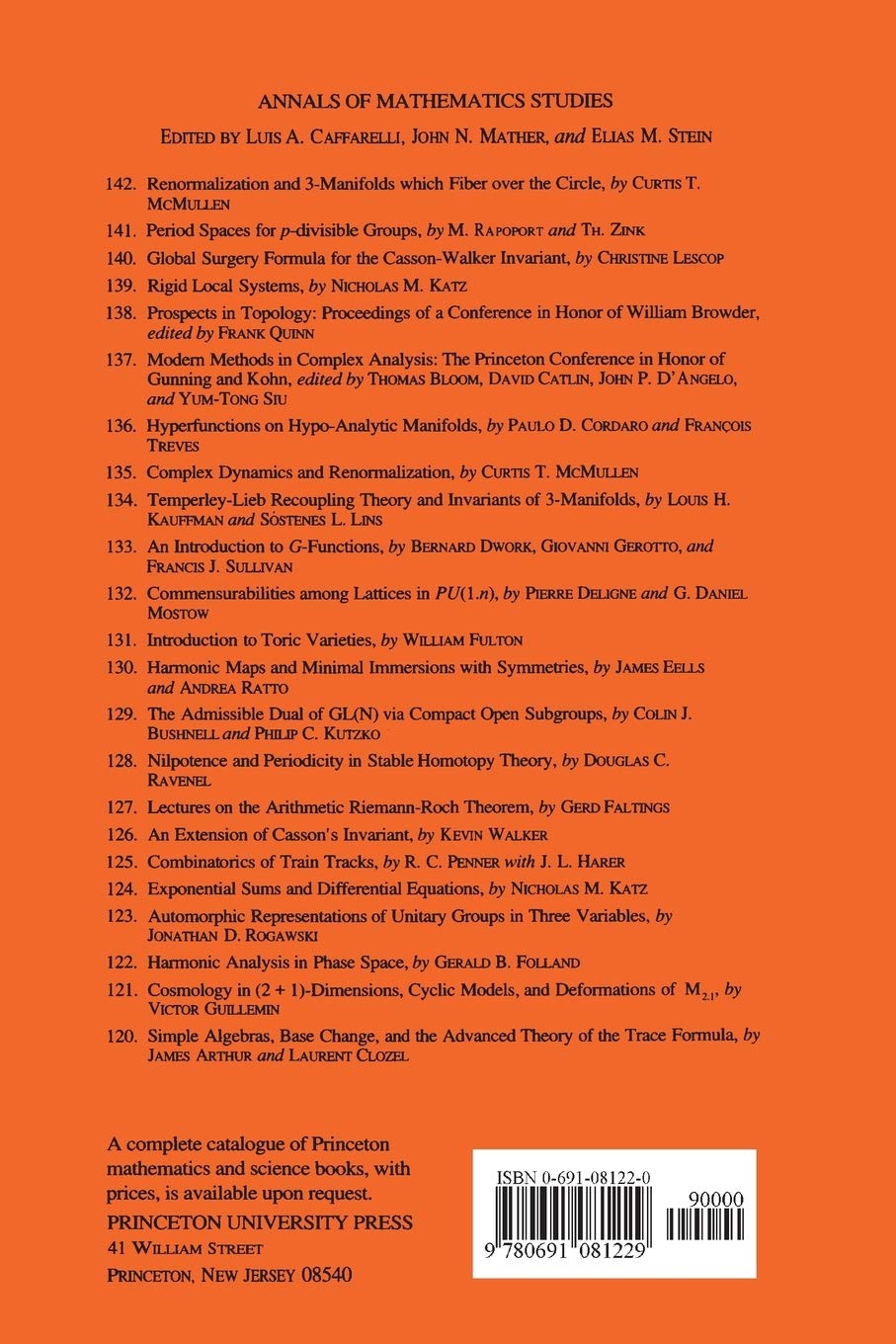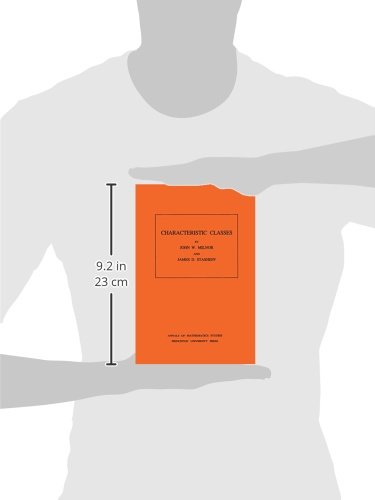



Full description not available
A**H
Essential for any geometer
Milnor's writing is, as always, exceptionally clear and concise. Foundational material for any geometry student. Every mathematician should own this. Every geometer should study it.
M**K
how many stars??
I read this page to see how Milnor's book could average only 4 stars. I found two unfair, but intelligent, 2/3 star reviews apparently by physicists, miffed that a masterful 50 year old book on the foundations of the topic, does not provide a history of their invention, and a survey of their current use in physics. If a book serves its own and its author's purpose wonderfully well, but does not serve yours, that is your fault, not the author's. As a hint, it is in the Annals of Math series, not the Handbook for Physicists series. Please read the chapter on "obstructions", p. 139. There Milnor succintly provides exactly the interpretation requested, and a reference to the classic text by Steenrod. The most important construction on a smooth manifold is its tangent bundle, and the basic question is whether smooth never zero vector fields exist. The subject begins with the theorem of Poincare & Hopf: a never zero vector field exists if and only if the topological euler characteristic of the underlying manifold is zero. For a polyhedron, this euler characteristic is the number V-E+F = vertices - edges + faces. Thus the most basic characteristic class is the euler class. Briefly, the others measure existence of sequences of independent vector fields. In 1957 their existence, construction and properties were clouded, and Milnor cleared this away once for all in these notes, published by demand and gratefully received by [almost] everyone. This is a great book, and a 2 star review only serves to rate ones own qualifications to appreciate it. I.e. these reviewers are rating not the book but its suitability for their own narrow interests. For another short introduction try the chapter in the book by Bott & Tu.
M**M
great at what it covers, but doesn't cover enough
Milnor & Stasheff's "Characteristic Classes" is the standard reference for them. It includes a number of different, but equivalent, definitions and properties of the Stiefel-Whitney, Chern, Euler, and Pontrjagin classes, with a formal, heavily algebraic topological flavor. The material presented is all easy to follow and well explained, and there are problems included in every chapter, some of which are challenging, earning this work its high reputation. However, there is a dearth of geometric intuition and many important, basic facts about the classes are absent, so while a student with only a standard background in algebraic topology and differential topology could read and understand the book, to really gain a practical knowledge of characteristic classes as one would need in studying, say, low-dimensional topology (let alone physics), the book must be supplemented with other book(s) on the subject, such as Bott & Tu's Differential Forms in Algebraic Topology .Characteristic classes associated to a fiber bundle are cohomology classes of the base manifold that behave naturally under pullbacks (i.e., the characteristic class of the pullback of a bundle is the pullback of the characteristic class of the bundle). In particular, the classic classes that this book deals with are associated to vector bundles, either real (the Stiefel-Whitney (S-W) and Pontrjagin classes), real orientable (the Euler class), or complex (Chern classes). There are several different ways of defining these classes, most of which are covered:- As obstructions to the extension of a trivialization of the bundle over the k-skeleton of the base manifold to a trivialization over the (k+1)-skeleton (for some k). Alternatively, as the obstruction to the existence of a certain number of linearly independent, nonzero sections of the bundle. Most applications of characteristic classes in topology focus on these properties. Unfortunately, relatively little space is dedicated to this approach, with much of the technical details being left to Steenrod's The Topology of Fibre Bundles .- As the pullback under the classifying map of the generators of the cohomology classes of the classifying space for the bundle. Since every bundle is isomorphic to the pullback under the classifying map of a universal bundle over such classifying space, this explains why characteristic classes have such significance - they are basic algebraic topological invariants for bundles that play a role similar to (co)homology groups for manifolds. Indeed, under certain circumstances, a few characteristic classes can uniquely specify a bundle (although the authors fail to mention this). Much of the book focuses on computing the cohomology rings of classifying spaces for real, real orientable, and complex vector bundles, but this unfortunately is not of much practical use.- As certain functions of the curvature of a connection on the bundle (Chern-Weil theory). This approach includes, among other applications, the Gauss-Bonnet theorem (covered in the Appendix), and is central to gauge theory in both physics and mathematics (not mentioned in this book). The treatment of this facet is inadequate - see, e.g., Kobayashi & Nomizu's Foundations of Differential Geometry (Volume 2) or Chern's Complex Manifolds without Potential Theory (With an Appendix on the Geometry of Characteristic Classes) for more depth. Secondary characteristic classes, such as Chern-Simons classes, are only mentioned in an epilogue - see Morita's Geometry of Characteristic Classes .- For Euler and S-W classes, the classes are intimately connected to the Thom isomorphism and Thom class of a vector bundle, which is one of the emphases of the book. The Thom Isomorphism Theorem is proved here as well.- For Chern classes, an induction procedure is used to define all other (lower) classes once the top class is defined. (It is also pointed out that a similar procedure can be followed for S-W classes.) This differs from the usual induction procedure that starts from the 1st class and works up. In fact, in one of the most surprising omissions from the book, there is no mention of the Splitting Principle for Chern (or S-W) classes.- The usual relations among the various classes are proved: The top S-W class is the mod 2 reduction of the Euler class, S-W classes are mod 2 reductions of Chern classes, etc. Pontrjagin classes are defined in terms of Chern classes.- A formal definition of characteristic classes can be given, where one just lists the properties that are needed to uniquely specify them (similar to the approach of defining homology via the Eilenberg-Steenrod axioms). While this does allow one to immediately start using the properties of the classes to derive other results, it provides no intuition about where the classes come from or why they are so important. Unfortunately, the authors elected to define the S-W classes in this fashion, and then only slowly derive the alternative characterizations of them, which is one reason why so many reviewers here (especially physicists) find this book to be unhelpful. Some patience is required when reading the book, but there is a payoff later on.The only examples for which these classes are actually computed are certain bundles over the standard projective spaces (for which this book is generally cited as a reference), (trivially) the spheres, and Grassmann manifolds.Much of the rest of the book is focused on (1) S-W, Chern, and Pontrjagin numbers and their implications for cobordism theories, but they only scratch the surface, referring the reader instead to Stong's Notes on cobordism theory ; and (2) multiplicative sequences, such as the L-genus and Todd classes, and in particular a proof of the Hirzebruch signature theorem, but no mention is made of the natural extension and application of these classes to the Atiyah-Singer Index theorem or the Riemann-Roch theorem.The remaining material comprises preliminary chapters on smooth manifolds (like in Milnor's Topology from the Differentiable Viewpoint defined only as subsets in R^n), singular homology and cohomology, and vector bundles. The reader should already be well familiar with these topics before opening this book.The biggest weaknesses of the book are the formal presentation, especially in the first chapter on S-W classes, and some glaring omissions, including not only the aforementioned ones, but also:- spin structures - in particular, that the vanishing of the 2nd S-W class implies the existence of such;- structure groups and transition functions for bundles - in particular, the concepts of characteristic classes being obstructions to liftings of bundles with one structure group to those of another and being expressible as cocyles in Cech cohomology (the authors acknowledge these omissions in the Epilogue);- explicit discussion of line bundles - in particular, the description of the first Chern class as the Poincare dual to the zeros of a generic section;- that the 2nd S-W class is a characteristic element for the intersection form for an oriented 4-manifold;- the exact sequence expressions for 1st Chern class or 1st and 2nd S-W classes;- that the 1st Chern class is an isomorphism between (isomorphism classes of) complex line bundles and the integers, and that the 1st S-W class is a similar isomorphism for real line bundles and Z/2Z;- the Dold-Whitney theorem that an oriented real vector bundle over an oriented 4-manifold is uniquely determined by its 1st Pontrjagin, Euler, and 2nd S-W classes, or that 2-plane complex (U(2)) bundle over a 4-manifold is uniquely determined by its 1st and 2nd Chern class;- differential-form expressions for any of these cohomology classes (except a little bit when discussing Chern-Weil theory).In short, while much important material has been left out (after all, the lectures on which this book was based were given in 1957!), what is covered is done very well. So this book should be one of your references for characteristic classes, but you'll need to supplement it with, e.g., Bott & Tu or Madsen & Tornehave's From Calculus to Cohomology: De Rham Cohomology and Characteristic Classes and possibly Scorpan's The Wild World of 4-Manifolds or Lawson & Michelson's Spin Geometry . Unfortunately, there doesn't seem to be any comprehensive book on even these classical characteristic classes that encompasses all the different aspects one would need to know.
J**M
Best, most easily understandable book he ever wrote.
This was topic for my 2nd oral exam at U of Chicago. Me and a couple of other fellows took turns lecturing on it to each other in preparation for same, to work out a few wrinkles of minor skips in proof which we found.He's a great expositor, and I think this one is his crowning achievement for regular guys like me.
Trustpilot
1 month ago
2 months ago